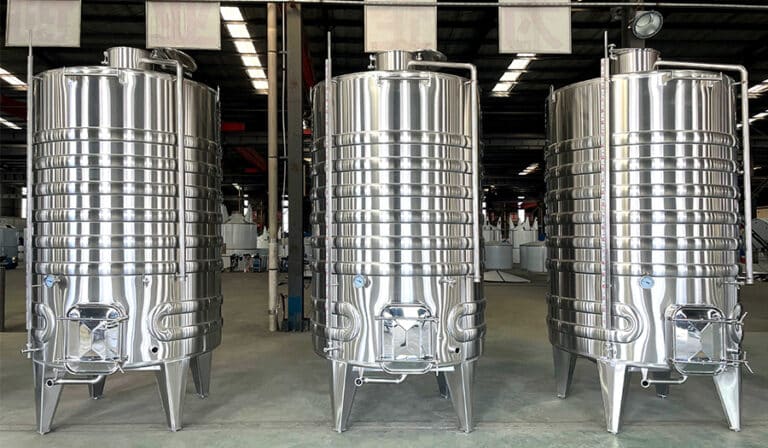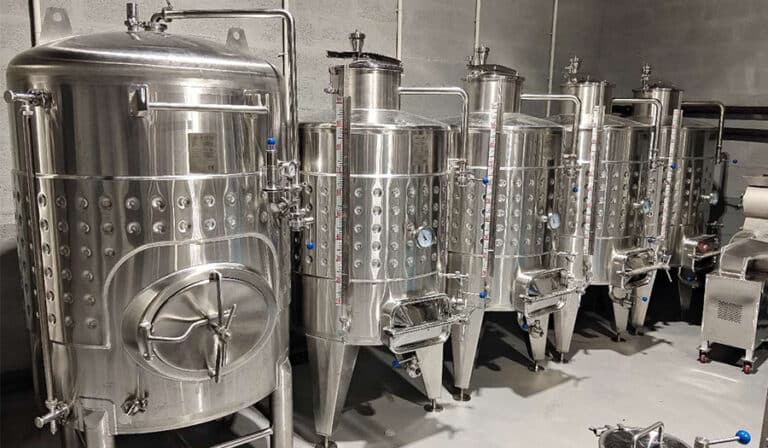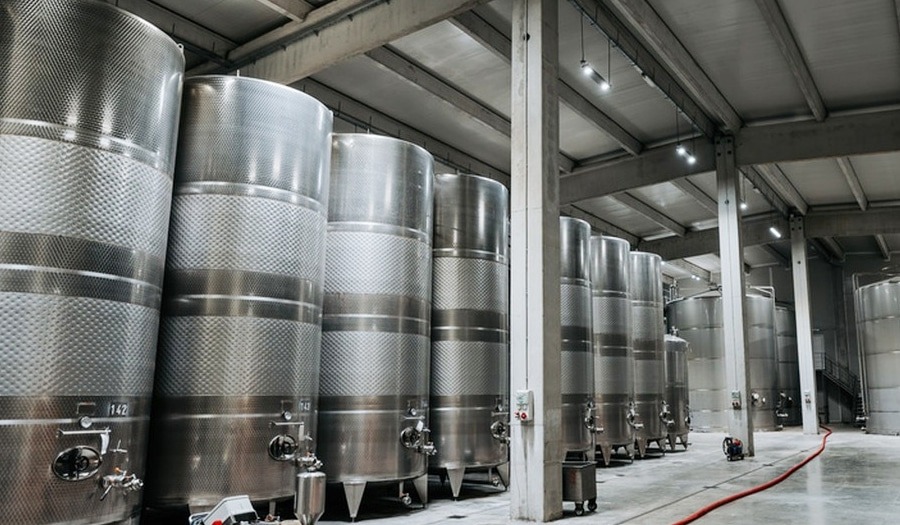In the world of winemaking, fermentation is a crucial process that directly affects the flavor, aroma, and final quality of the wine. Traditional wine fermentation uses wooden barrels, however, with the advancement of winemaking technology, stainless steel fermentation tanks have gradually become the choice of many winemakers. So, can stainless steel fermentation tanks be used to ferment wine? The answer is obviously yes. Stainless steel fermentation tanks can not only be used to ferment wine but also have many advantages that traditional wooden barrels cannot match.
What is a wine fermentation tank?
A wine fermentation tank is a stainless steel container used to ferment grape juice. It is corrosion-resistant, easy to clean, and has stable temperature control. The main function of the fermentation tank is to support the yeast in converting the sugar in the grape juice into alcohol and carbon dioxide.
Types of fermentation tanks:
- Open fermentation tanks: Most commercial wineries ferment red wine in open containers to allow heat to dissipate and make the lid more accessible. When you ferment on the skins, the skins will float to the top and stick to the lid. This lid protects the wine from wind and rain, but it must also be pressed back into the wine occasionally to help extract more flavor and aroma compounds from the skins.
- Closed fermentation tanks: Closed-top wine fermentation tanks are used for non-oxidative wine fermentation. This type of fermentation tank is best suited for white wines. The top of the tank remains sealed during fermentation, and an inert gas such as nitrogen is used to fill the head space in the tank and replace oxygen. Wines brewed in this way have a fresh taste and are suitable for early drinking.

Types of materials used in wine fermentation tanks
Oak
With oak barrels, oxygen flows more slowly into the wine. This way, the tannins of the wine are softer. In addition, the degree of toasting of the oak barrels also affects the flavor of the wine. The barrels can release aromas and flavors such as vanilla, spices, and smoke into the wine, enhancing the complexity of the wine. The barrels allow a small amount of oxygen to enter, which helps the wine mature and, through fermentation, can make the wine softer and mellow.
Concrete
Concrete tanks come in various shapes, such as square, rectangular, or egg-shaped. Some tanks are open, while others are tightly locked to prevent oxygen from entering the wine. Concrete gives the wine a neutral flavor, but sometimes it can also give the wine a mineral taste.
Stainless steel
Stainless steel is one of the most commonly used materials in modern winemaking. When not in use, the tanks remain closed. Inert gas fills any space in the tank and replaces oxygen. Stainless steel also does not impart any unique flavors to the wine. Stainless steel tanks are an excellent choice for wines that need to be kept cold during fermentation because they have the best cooling capabilities.
Plastic tanks
Plastic tanks are generally used for small-scale home winemaking or in the early stages of wine fermentation. Plastic jars are light and easy to carry. Compared with other materials, plastic is cheaper and less prone to breakage, but it is less durable and more prone to bacteria.
Advantages of stainless steel red wine fermentation tanks
- Temperature control: Stainless steel fermentation tanks are usually equipped with a temperature control system that can adjust the fermentation temperature in time. This helps winemakers maintain an ideal environment throughout the fermentation process, ensuring that the yeast works at the optimal temperature, thereby improving the fermentation effect.
- Easy to clean and maintain: The surface of stainless steel materials is smooth and very convenient to clean. However, wooden barrels are prone to residual dirt during the cleaning process, which may lead to the growth of miscellaneous bacteria during the fermentation process. Therefore, the use of stainless steel fermentation tanks can reduce the risk of contamination and ensure the purity of the wine.
- Strong corrosion resistance: Stainless steel is not easily corroded by acidic substances and other substances, so it will not affect the taste of the wine due to long-term use like wooden barrels. This makes stainless steel tanks perform well during long-term storage and fermentation.
- Short fermentation cycle: Stainless steel tanks have good thermal conductivity and can promote yeast activity. Compared with traditional wooden barrels, stainless steel tanks can shorten the fermentation cycle and improve winemaking efficiency.
- High transparency: Many stainless steel tanks are equipped with observation windows, so winemakers can monitor the fermentation process at any time and adjust relevant parameters in time. This provides winemakers with greater flexibility and control.
- Cost-effectiveness: Compared with oak barrels, stainless steel barrels are generally more cost-effective. They last longer and require less maintenance and upkeep. Spare accessory valves and other keg parts are always available online.

Can stainless steel fermentation tanks ferment red wine?
Yes, stainless steel fermentation tanks can be used to ferment red wine, and have become a widely used equipment in modern winemaking.
- Temperature control capability: Stainless steel fermentation tanks are usually equipped with advanced temperature control systems, which are essential for the fermentation process of red wine. The optimal temperature for red wine fermentation is generally between 20°C and 30°C. By precisely controlling the temperature, it can ensure that the yeast works in the best condition, thereby promoting the formation of flavor and aroma.
- Controllability and flexibility: With stainless steel fermentation tanks, winemakers can experiment more flexibly and try different yeast strains, fermentation conditions, and techniques. This helps to create a variety of styles of red wine to meet the changing needs of consumers in the market.
- Cleanliness and hygiene: Stainless steel materials have a smooth surface and are easy to clean. This can effectively reduce the risk of infection by bacteria during the fermentation process, ensure the purity of the wine, and avoid unnecessary flavor interference.
- Corrosion resistance: Stainless steel has strong corrosion resistance and can resist the acidic components in the wine. It will not release any harmful substances during the fermentation process, ensuring the quality and safety of the wine.
- Micro-oxygenation characteristics: Many stainless steel tank designs take into account the need for micro-oxygenation, which may be introduced through vent adjustment to achieve moderate oxidation. This is crucial for the development of red wine flavor and the enhancement of complexity.
- Enhanced wine stability: Stainless steel fermentation tanks can effectively control the fermentation process, reduce the risk of oxidation, and maintain the stability of the wine. This allows red wine fermented in stainless steel to maintain its quality even after long-term storage.
How to choose a stainless steel wine fermentation tank?
Size and capacity
The size of the fermentation tank should match the size of your brewery. Consider your brewing volume and target production to choose the right tank capacity. Small wineries or home brewers may choose smaller tanks (such as 100 liters to 500 liters), while large-scale wineries may need larger tanks (such as 1000 liters or more).
Material and thickness
Choose 304 or 316 stainless steel materials, as these two materials have good corrosion resistance and high temperature resistance, suitable for long-term contact with the wine. Thicker stainless steel can provide better durability and insulation, ensuring better temperature control.
Fermentation tank design
Round fermentation tanks are generally more common, which helps gas circulation and even temperature distribution. Flat-bottomed tanks make it easier to clean up sediment.Make sure the opening of the tank is large enough for easy addition of raw materials, cleaning, and maintenance. Some designs have a sloped bottom to help drain sediment more easily.
Temperature control system
Stainless steel tanks with integrated cooling jackets are essential for precise temperature control during fermentation. If you need additional control over the fermentation temperature, consider using insulated tanks to prevent temperature fluctuations.
Open or closed top
Commonly used for red wine fermentations as they facilitate hand pressing of the grape skins to extract color and tannins. They are more flexible but may require more labor to manageHydrogen Closed Tanks: Preferred for white wine fermentations to limit exposure to oxygen. These tanks often come with airlock fittings to allow carbon dioxide to escape while preventing oxygen from entering.

Agitation and Mixing Options
Built-in AgitatorFor some wines, especially during cold stabilization or fermentation where exposure to hydrogen is required, tanks with built-in agitators can help with even mixing.
Portability and Installation
Larger fermentation tanks are usually mounted in place and connected to a cooling system, making them ideal for larger wineries. Smaller tanks may need to be moved around the winery, so consider models with carts for easier transportation.
Conclusion
Stainless steel fermentation tanks can be used for the fermentation of red wine and have advantages in many aspects. With the development of winemaking technology, more and more winemakers choose to use stainless steel fermentation tanks to create high-quality red wine to meet market demand. Therefore, using stainless steel fermentation tanks to ferment red wine is not only feasible but also can improve the quality and flavor of red wine in many aspects.




